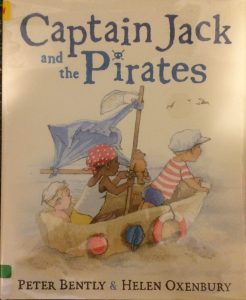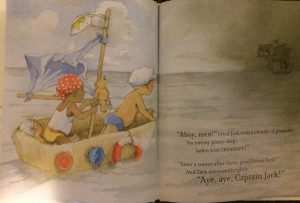Author: Peter Bently
Illustrator: Helen Oxenbury
Publisher and Year: Dial Books for Young Readers, 2015
Number of Pages: 30 Pages
Genre: Fantasy, Fiction
This story tells of the tale of three boys (Jack, Zack, and Caspar) and their whimsical adventures at the beach. The three boys encounter an enemy pirate ship that has the treasure the boys are seeking. The boys get shipwrecked on an island, but still continue on “hungry for glory and enemy booty” (Bently, 2015).
The story is used as a window because it shows the imagination of younger children and the crazy adventures they can make in any kind of place. As a mirror, it reminds a reader of any age the fun and joy of using one’s imagination to create anything. Also, it serves as a door to encourage all that imagination never dies and is the opportunity to be anything one wants to be. For the most part, the power is in the hands of the three boys because they collectively create and engage in the world with the enemy pirates. As the story goes on, they do indeed find the treasure: an abundance of cupcakes, soda, ice cream, and cake. In addition, the reader finds out that the “enemy pirates” were just the adults the three boys came with, attempting to get them ready to leave the beach. This book is not very diverse in terms of skin color, with the exception of Captain Jack’s right hand man Zack (African American). Also, all the “enemy pirates” are Caucasian. As one looks through the images, the adults in the story were the boys’ parents (both Caucasian) and act as if Zack is their son. Based on this, I can say the book is a little more diverse because the illustrator is showing a mixed family. At the same time, the family has only three boys and the only female figure in the story is the mother who brings the boys ice cream at the end of the book. In this story, it is mainly a male and Caucasian culture represented. In a like manner, the culture of young children’s imagination is represented in the creative adventure of the three boys.
Perceptually, the words and text mirror one another signaling the importance of both the image and text. In addition, the pictures take up most of page but text is easy to find. This means that though the images are important, the reader can focus on the text as well. Structurally, words within the text rhyme, allowing the reader to learn a simple structure of poetry and other words. On the contrary, there are some images are colored while some are black and white. The ones with color symbolize the boys on their adventures while black and white stand for the real world. The three boys also wear similar swimsuits standing for the time period of the story and/or making them equal. In addition, the beach is backdrop for the boys’ adventure, which means their imagination, can be very creative in a simple setting. Prevalent themes from this book are imagination never dies and anyone the opportunity to be anything they want to be.


